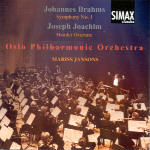[RIP Mariss Jansons]
Jansons’ previous two releases in his Brahms cycle featured excellent playing in a generalized sort of way, but little more. This final installment is different. Instead of surface prettiness and a moment-by-moment fussing over details, Jansons has mastered the Brahmsian art of transition while at the same time encouraging his orchestra to put a real bottom on their sound, building the sonority from the bass line up. You can hear this immediately: the introduction’s pounding timpani and wailing instrumental lines have a power that comes from density of texture as much as sheer volume. In general, Jansons adopts swift tempos, but he relaxes beautifully into the first movement’s second subject, and handles the entire development section and the long passage leading into the recapitulation as a single, breathtakingly sustained paragraph. This same bigness of conception applies equally to the Andante, swiftly flowing but gorgeously phrased as a grand expanse of lyric melody.
After the lithe and pastoral third movement, Jansons opens the finale with as perfect an introduction as I ever hope to hear. I compared him to the legendary 1951 Furtwängler/Hamburg version on Tahra, and Jansons has the old boy beat by a mile. Even his timpanist does his German counterpart one better. Solo horns and flute also sound magnificent. The remainder of the finale shows the same flexibility of pulse and hugely exciting climaxes as the opening movement. Jansons manages the “animato” counterstatement of the main theme particularly impressively, his exquisite sense of timing allowing him to deliver a surge of energy without either an excessive gear shift or Furtwängler’s rather clumsily managed accelerando. The coda’s genuine nobility, with the grand chorale played as written in a triumphant vindication of Brahms’ scoring, caps an absolutely outstanding achievement.
The coupling, Joachim’s Hamlet Overture, shows exactly why this seminal figure in the history of 19th century music was right to give up composition. He had a real gift for orchestration, not in any revolutionary sense of pushing instruments beyond their traditional capacity or in his employment of unusual sonorities, but in terms of his ability to create a sonorous, well-balanced texture at all dynamic levels. This, combined with a lively rhythmic sense, keeps Hamlet moving for much of its 15 minutes. Unfortunately, Joachim’s melodic inspiration was distinctly second rate. The opening Moderato theme repeats itself endlessly, while the Allegro agitato has to make do with the most emotionally neutral material imaginable. This, combined with a certain lack of direction at the climaxes, makes the piece sound much longer than it really is. Still, Jansons plays it very well, and its appropriateness as a compliment to the symphony is undeniable. Simax has captured both works with stunning realism, clarity, and warmth.
































